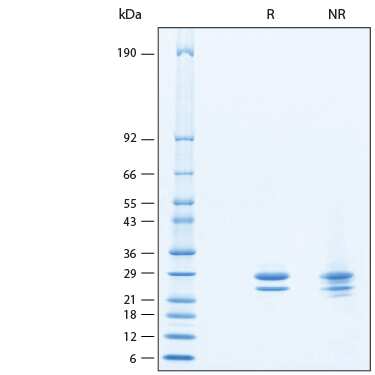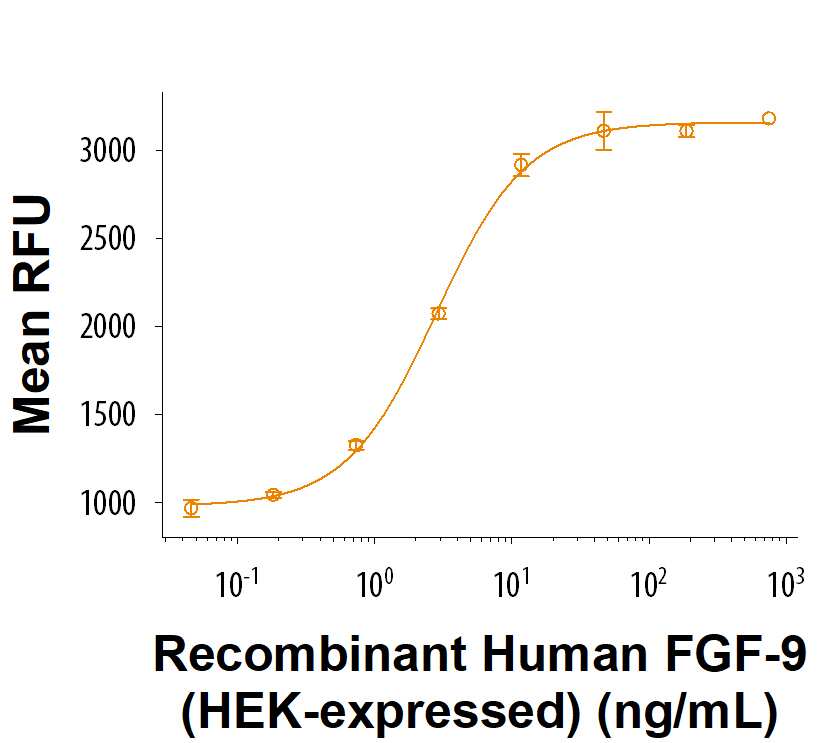Recombinant Human FGF-9 (HEK293-expressed) Protein, CF
R&D Systems, part of Bio-Techne | Catalog # 11233-F9

Key Product Details
Product Specifications
Source
Human embryonic kidney cell, HEK293-derived human FGF-9 protein
Ala2-Ser208 & Leu4-Ser208
Ala2-Ser208 & Leu4-Ser208
Purity
>95%, by SDS-PAGE visualized with Silver Staining and quantitative densitometry by Coomassie® Blue Staining.
Endotoxin Level
<0.10 EU per 1 μg of the protein by the LAL method.
N-terminal Sequence Analysis
Ala2 & Leu4
Predicted Molecular Mass
23 kDa
SDS-PAGE
23-30 kDa, under reducing conditions.
Activity
Measured in a cell proliferation assay using Balb/3T3 mouse embryonic fibroblast cells. Rubin, J.S. et al. (1991) Proc. Natl. Acad. Sci. USA 88:415. The ED50 for this effect is 1.00-5.00 ng/mL.
Scientific Data Images for Recombinant Human FGF-9 (HEK293-expressed) Protein, CF
Recombinant Human FGF-9 (HEK293-expressed) Protein Bioactivity.
Measured in a cell proliferation assay using Balb/3T3 Mouse Embryonic Fibroblast cells. Rubin, J.S. et al. (1991) Proc. Natl. Acad. Sci. USA 88:415. The ED50 for this effect is 1.00-5.00 ng/mL.Recombinant Human FGF-9 (HEK293-expressed) Protein SDS-PAGE.
2 μg/lane of Recombinant Human FGF-9 (HEK293-expressed) Protein (Catalog # 11233-F9) was resolved with SDS-PAGE under reducing (R) and non-reducing (NR) conditions and visualized by Coomassie® Blue staining, showing bands at 23-30 kDa.Formulation, Preparation and Storage
11233-F9
| Formulation | Lyophilized from a 0.2 μm filtered solution in MOPS, Na2SO4 and EDTA with Trehalose. |
| Reconstitution | Reconstitute at 250 μg/mL in sterile water. |
| Shipping | The product is shipped with polar packs. Upon receipt, store it immediately at the temperature recommended below. |
| Stability & Storage | Use a manual defrost freezer and avoid repeated freeze-thaw cycles.
|
Background: FGF-9
References
- Mohammadi, M. et al. (2005) Cytokine Growth Factor Rev. 16:107.
- Itoh, N. and D.M. Ornitz (2008) Dev. Dyn. 237:18.
- Miyamoto, M. et al. (1993) Mol. Cell. Biol. 13:4251.
- Santos-Ocampo, S. et al. (1996) J. Biol. Chem. 271:1726.
- Plotnikov, A.N. et al. (2001) J. Biol. Chem. 276:4322.
- Harada, M. et al. (2009) Nat. Genet. 41:289.
- Wu, X.L. et al. (2009) Am. J. Hum. Genet. 85:53.
- Colvin, J.S. et al. (1999) Dev. Dyn. 216:72.
- Lin, Y. et al. (2009) Dev. Biol. 329:44.
- Hung, I.H. et al. (2007) Dev. Biol. 307:300.
- Colvin, J.S. et al. (2001) Dev. Dyn 128:2095.
- Krejci, P. et al. (2009) Hum. Mutat. 30:1245.
- Leushacke, M. et al. (2011) PLoS ONE 6:e23381.
- Hendrix, N.D. et al. (2006) Cancer Res. 66:1354.
- Abdel-Rahman, W.M. et al. (2008) Hum. Mutat. 29:390.
Long Name
Fibroblast Growth Factor 9
Alternate Names
FGF9
Gene Symbol
FGF9
UniProt
Additional FGF-9 Products
Product Documents for Recombinant Human FGF-9 (HEK293-expressed) Protein, CF
Product Specific Notices for Recombinant Human FGF-9 (HEK293-expressed) Protein, CF
For research use only
